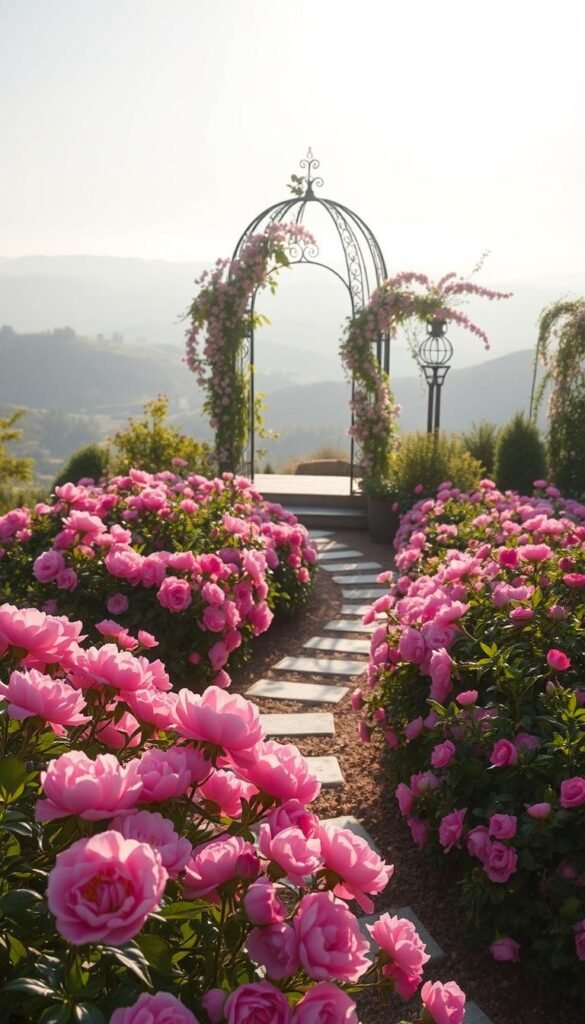Imagine stepping into a serene retreat where gentle colors blend seamlessly with nature’s rhythm. Soft-hued blossoms can turn ordinary yards into inviting sanctuaries, offering both visual harmony and emotional calm. These spaces invite you to unwind while adding personality to your property.
Varying shades of blush, coral, and rose create depth in your landscape. Pairing delicate petals with textured foliage ensures year-round interest, even when blooms fade. From compact borders to sprawling arrangements, these plantings adapt to any size or layout.
Strategic placements—like framing walkways or accenting seating areas—add structure to free-flowing designs. Decorative stones, rustic benches, or subtle lighting elevate the atmosphere without overwhelming the natural beauty. This approach balances creativity with practicality for lasting appeal.
Whether you prefer tidy geometric patterns or wild cottage-style clusters, the right combinations foster timeless charm. Thoughtful plant selection ensures staggered blooming cycles, keeping your space vibrant from spring through fall. It’s about crafting an environment that feels uniquely yours while celebrating nature’s quiet elegance.
Introduction to Inspiring Flower Bed Designs
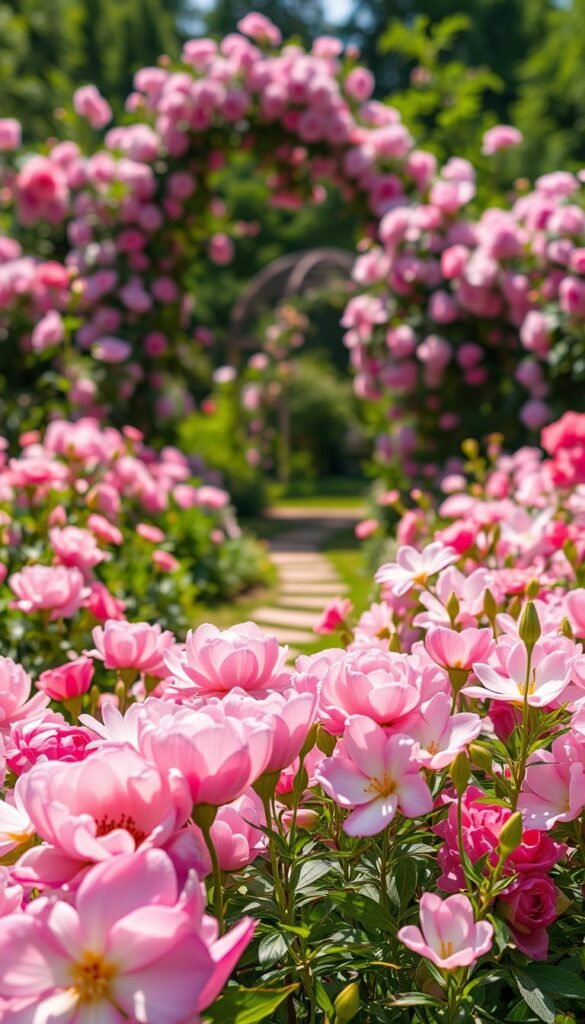
Your yard holds potential—unlock it with creative arrangements that pop with life. From bold zinnias to elegant white roses, these 32 flower bed ideas offer fresh ways to enhance your outdoor space. Even small gardens can become captivating displays with smart plant combinations.
Mixing heights and textures creates visual interest that draws attention. Tall canna lilies pair well with low-growing bellflowers, while clustered zinnias add bursts of color. Consider these popular options for different effects:
| Plant Type | Height Range | Bloom Period |
|---|---|---|
| Roses | 2-6 ft | Spring-Fall |
| Canna Lilies | 3-8 ft | Summer |
| Bellflowers | 6-24 in | Late Spring |
Simple borders or winding pathways both work beautifully. Focus on sunlight patterns and soil quality when choosing plants. Maintenance needs vary—some flowers thrive with minimal care, while others demand regular pruning.
Seasonal planning keeps your garden lively year-round. Early bloomers like tulips give way to summer stars like lilies, followed by autumn chrysanthemums. This rotation ensures continuous color without overwhelming upkeep.
Planning Your Dream Garden Layout
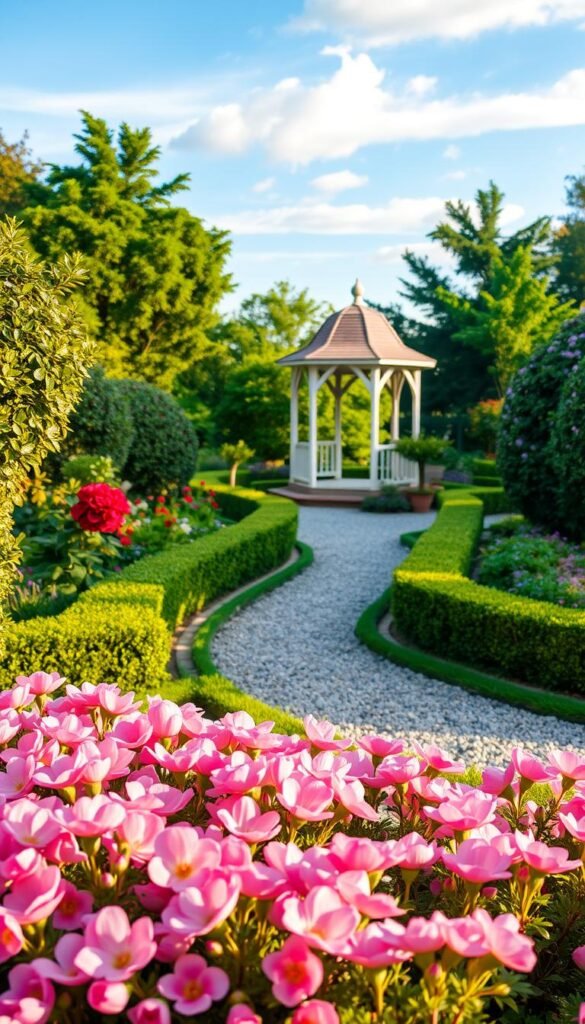
A well-designed garden starts with understanding your yard’s unique characteristics. Before digging, test your soil and research plants suited to your climate. This groundwork ensures your efforts bloom into lasting beauty.
Identifying Ideal Spots in Your Yard
Walk your property at different times to map sunlight patterns. Full-sun areas might host roses, while shaded spots could nurture hydrangeas. Check for drainage by noting where puddles linger after rain.
Prioritize space near walkways or seating for easy enjoyment. Avoid placing beds too close to tree roots or utility lines. These simple checks prevent headaches later.
Measuring Available Space Effectively
Use a tape measure or digital tool to record dimensions accurately. Sketch your yard’s shape, marking permanent features like patios. This helps visualize how beds will fit proportionally.
Consider sightlines from windows and pathways to create focal points. Leave room between plantings for growth and maintenance access. A balanced look ties everything together seamlessly.
Group plants with similar water needs in the same area. This smart zoning simplifies care while conserving resources. Your garden becomes both practical and picturesque.
Soil Preparation and Garden Bed Maintenance
Healthy blooms begin beneath the surface—where roots meet nutrient-rich earth. You’ll want to start by loosening the top 6-8 inches of soil with a garden fork. This breaks up compacted dirt, letting air and water reach plant roots more easily. Mix in compost or aged manure to boost nutrients naturally.
Testing your soil’s pH reveals whether it’s acidic or alkaline. Most flowering plants thrive in slightly acidic conditions (6.0-7.0 pH). If needed, add lime to raise pH or sulfur to lower it. “Balanced soil means happier plants,” says one local horticulturist. This step ensures your bed supports growth from day one.
After planting, spread 2-3 inches of mulch around your flowers. Bark chips or straw keep roots moist and block weeds. Check soil weekly—stick your finger an inch deep. If it’s dry, give your garden a slow, deep watering early in the morning.
Stay ahead of weeds by pulling them when small. Spot yellow leaves? They might signal overwatering or pests. A simple routine keeps your bed vibrant without constant work. Healthy soil truly does most of the heavy lifting!
Pretty Pink Flower Garden Themes: Romantic and Eye-Catching Bed Designs
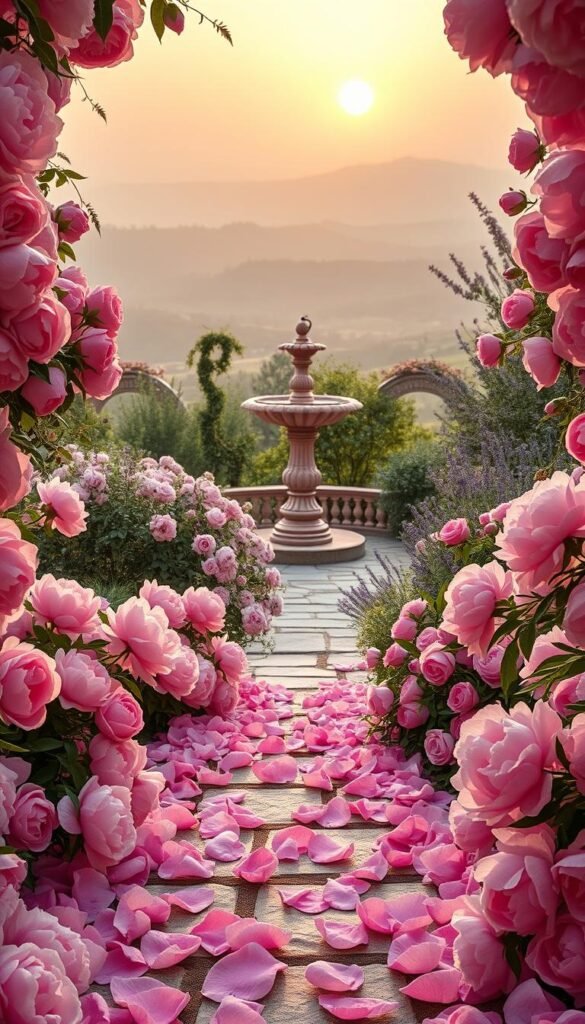
Transform your outdoor space into a haven of tranquility with soft-toned blossoms and thoughtful accents. Start by planting a curved flower bed filled with fragrant roses and lavender—their complementary hues create a soothing palette. Add a weathered stone bench or wrought-iron bistro set to invite relaxation amidst the blooms.
Layer peonies and cherry blossoms around taller rose bushes for staggered design. This approach ensures continuous color from spring through fall. Pair these with silvery-green foliage plants to highlight delicate petal textures.
Vertical elements like arched trellises draped in climbing varieties add dimension. They create natural privacy screens while showcasing cascading flowers. For added charm, position a small fountain nearby—its gentle sounds enhance the peaceful ambiance.
- Mix early-blooming tulips with late-season asters
- Use gravel pathways to frame planting zones
- Install subtle solar lights to extend evening enjoyment
Maintain balance by leaving open spaces between lush garden areas. This prevents visual clutter while emphasizing key features. With careful planning, your sanctuary becomes a daily retreat that nourishes both eyes and spirit.
Exploring Creative Flower Bed Ideas for Curb Appeal
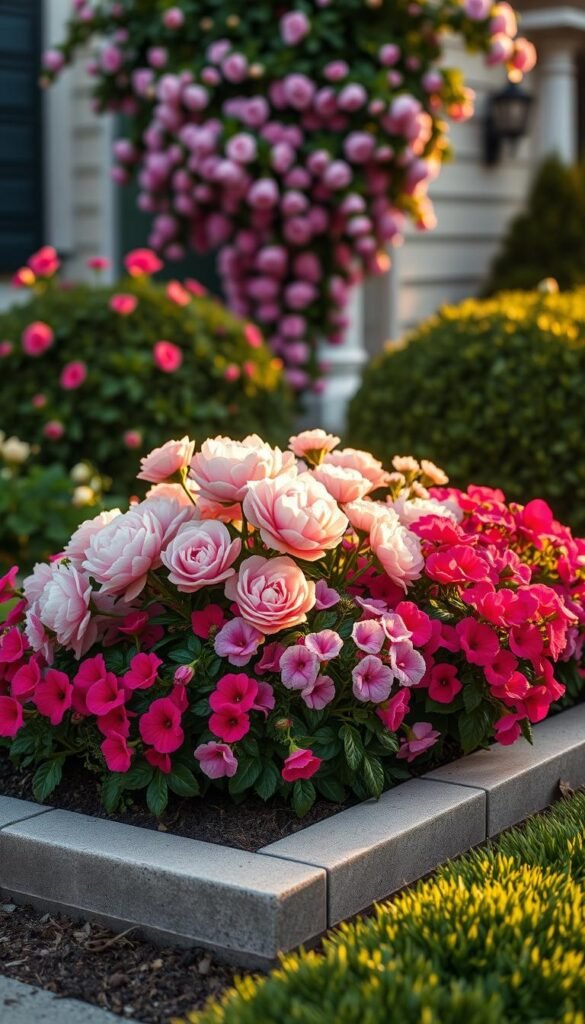
Want to boost your home’s first impression? Start by framing your property lines with layered flower beds. Tall ornamental grasses like maidenhair or fountain grass create a living screen along fences, while shorter plants like petunias add bursts of color up front. This approach maximizes vertical space while softening hard boundaries.
Your mailbox offers another prime planting spot. Surround its base with compact flowers like marigolds or dwarf zinnias. These low-maintenance options thrive in tight spaces while greeting visitors with cheerful hues. Pro tip: match bloom colors to your house trim for cohesive curb appeal.
Break free from predictable shapes by designing curved bed edges. Gentle arcs along pathways or around trees create movement in your garden. For small yards, try vertical stacks of trailing lobelia in wall planters. They add height without eating up ground area.
- Mix cascading ivy with upright salvia in tiered containers
- Use stone borders to define organic-shaped planting zones
- Position focal beds near entryways to guide attention
Strategic placements can highlight architectural details or disguise utility boxes. A well-placed flower bed transforms overlooked corners into charming features. With smart design choices, your landscape becomes a welcoming preview of your home’s personality.
Layering Plants for Visual Height and Texture
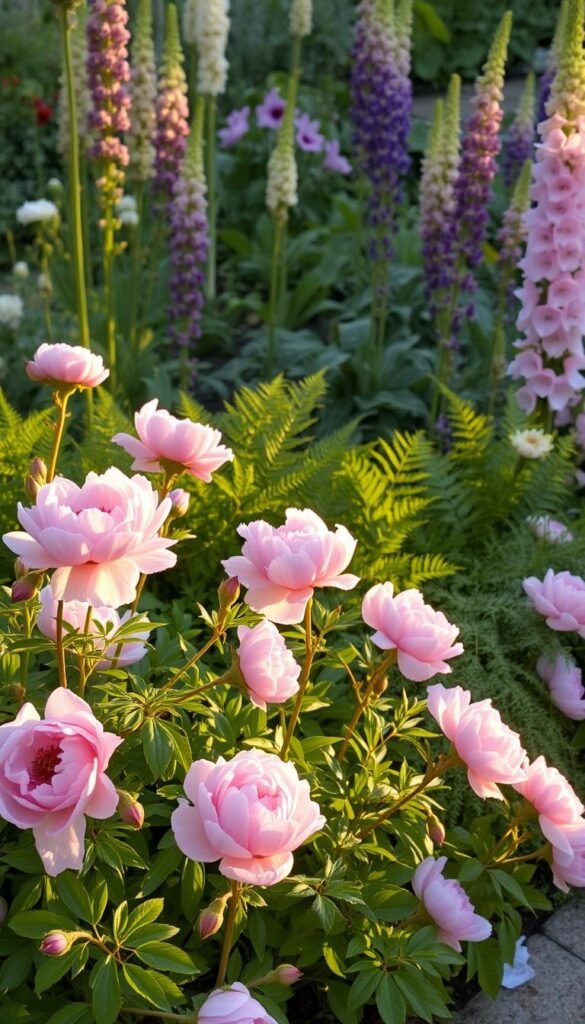
Turn simple plantings into striking displays with strategic layering. By arranging greenery in distinct tiers, you create depth that draws the eye upward and outward. This method transforms flat spaces into dynamic landscapes bursting with personality.
Tall, Medium, and Ground Cover Layers
Start with tall plants like miscanthus grass or climbing hydrangeas at the back of your bed. These natural backdrops add vertical drama while hiding fences or walls. Their wispy textures contrast beautifully with bold flowering shrubs in front.
Middle layers bridge height gaps. Try cone flowers or Russian sage—their medium stature fills space without blocking views. Mix leaf shapes: spiky iris blades beside round hosta leaves create visual interest through texture play.
Finish with creeping thyme or sedum along the bed’s edge. These ground huggers conceal bare soil while softening hard borders. Pro tip: Overlap plant canopies slightly for seamless transitions between levels.
Explore more flower bed ideas to experiment with different combinations. Layering works magic in small yards too—dwarf trees can substitute traditional tall plants when space is limited. The key lies in balancing proportions for that full, polished look.
Creative Edging and Unique Bed Designs
Define your landscape’s personality through crisp lines and imaginative shapes. Edging acts like a picture frame for your flower bed, highlighting its beauty while keeping mulch in place. Whether you prefer modern minimalism or rustic charm, materials set the tone.
At Bower & Branch, we believe “edges should whisper style, not shout for attention.” Reclaimed bricks laid diagonally add vintage flair, while smooth river rocks create organic flow. For contemporary spaces, try powder-coated metal strips that disappear into the ground.
Edging Materials and Design Patterns
Mix materials to match your home’s architecture. Stacked slate works with stone cottages, while cedar planks complement farmhouse styles. Curved beds soften angular yards, making narrow spaces feel wider. A circular arrangement around trees turns awkward roots into charming focal points.
Elevate simple layouts with tiered designs. Sunken flower beds lined with cobblestones create cozy nooks, while raised planters edged with woven willow add texture. These solutions tackle slopes or poor drainage while boosting visual depth.
Don’t fear asymmetry—zigzag patterns modernize traditional landscapes. Alternate tall ornamental grasses with low-growing thyme along winding paths. Your bed edges become part of the garden’s story, blending function with artistry.
Incorporating Pollinator-Friendly and Drought-Tolerant Plants
Your garden can buzz with life while conserving resources—if you pick the right green allies. By blending native plants with drought-resistant varieties, you create spaces that thrive with minimal effort. This approach supports local ecosystems and saves water without sacrificing beauty.
Choosing Native and Resilient Varieties
Start by researching species naturally adapted to your region. Native plants like purple coneflower or goldenrod handle local weather extremes better than exotic imports. Their deep roots access water efficiently, reducing irrigation needs during dry spells.
Attracting Bees, Butterflies, and Other Pollinators
Plant clusters of flowers in varying shapes to welcome diverse visitors. Flat blooms like zinnias offer easy landing pads for bees, while tubular varieties like salvia entice hummingbirds. Include milkweed for monarch butterflies—they’ll lay eggs on the leaves.
Time blooms to provide nectar from spring through fall. Early-blooming crocuses feed emerging pollinators, while asters sustain them into autumn. Pair these with ornamental grasses for texture and winter shelter.

